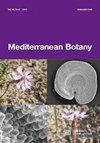缬草生物学意义的更新
IF 0.7
4区 生物学
Q3 PLANT SCIENCES
引用次数: 4
摘要
缬草(Caprifoliaceae)传统上用于治疗轻度神经紧张和睡眠问题。这些活性的基础主要归因于缬草酸通过调节GABA受体。此外,V.officinalis被声称具有其他生物活性,如心血管益处、抗癌、抗菌和解痉挛。本综述旨在更新缬草及其主要次级代谢产物的生物学和药理学研究(体外、体内和临床试验),以指导未来的研究。PubMed、Science Direct和Scopus数据库用于文献检索,包括2014年至2020年间发表的英文原创论文。已经确定了33篇符合纳入标准的文章。这些工作大多是用缬草提取物进行的,只有少数论文(体外和体内研究)评估了分离的化合物(缬草酸和草乌肾酸K)的活性。体外研究的重点是研究抗氧化和神经保护活性。体内研究和临床试验主要研究对神经系统的活性(抗惊厥活性、抗抑郁活性、认知问题、焦虑和睡眠障碍)。只有少数研究关注其他不同的活动,强调对经前和绝经后综合征症状的影响。缬草仍然是当今社会使用最多的药用植物之一,因为它具有治疗特性,其生物学和药理学活性继续引起人们的极大科学兴趣,最近的出版物证明了这一点。这篇综述显示了科学的证据,在传统用途的缬草对神经系统。本文章由计算机程序翻译,如有差异,请以英文原文为准。
Updating the biological interest of 'Valeriana officinalis'
Valeriana officinalis L. (Caprifoliaceae) has been traditionally used to treat mild nervous tension and sleep problems. The basis of these activities are mainly attributed to valerenic acid through the modulation of the GABA receptor. Moreover, V. officinalis is claimed to have other biological activities such as cardiovascular benefits, anticancer, antimicrobial and spasmolytic. The current review aims to update the biological and pharmacological studies (in vitro, in vivo and clinical trials) of V. officinalis and its major secondary metabolites in order to guide future research. Databases PubMed, Science Direct and Scopus were used for literature search including original papers written in English and published between 2014 and 2020. There have been identified 33 articles which met inclusion criteria. Most of these works were performed with V. officinalis extracts and only a few papers (in vitro and in vivo studies) evaluated the activity of isolated compounds (valerenic acid and volvalerenal acid K). In vitro studies focused on studying antioxidant and neuroprotective activity. In vivo studies and clinical trials mainly investigated activities on the nervous system (anticonvulsant activity, antidepressant, cognitive problems, anxiety and sleep disorders). Just few studies were focused on other different activities, highlight effects on symptoms of premenstrual and postmenopausal syndromes. Valeriana officinalis continues to be one of the medicinal plants most used by today's society for its therapeutic properties and whose biological and pharmacological activities continue to arouse great scientific interest as evidenced in recent publications. This review shows scientific evidence on traditional uses of V. officinalis on nervous system.
求助全文
通过发布文献求助,成功后即可免费获取论文全文。
去求助
来源期刊

Mediterranean Botany
Agricultural and Biological Sciences-Plant Science
CiteScore
2.40
自引率
10.00%
发文量
30
审稿时长
12 weeks
期刊介绍:
Mediterranean Botany (ISSNe 2603-9109), formerly Lazaroa, is a biannual journal that publishes original research studies in the field of Botany including plant systematics, vegetation ecology, biogeography, evolutionary biology, ecophysiology, community ecology, ethnobotany and conservation biology on Mediterranean biomes but also in interacting areas.
Mediterranean Botany is an OPEN ACCESS Journal, free of charges for any published article.
 求助内容:
求助内容: 应助结果提醒方式:
应助结果提醒方式:


